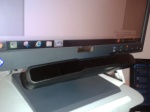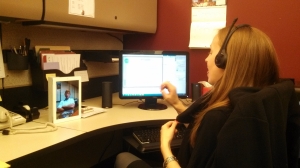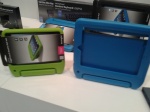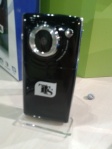 Note: this article assumes some previous knowledge of eye gaze technology.
Note: this article assumes some previous knowledge of eye gaze technology.
For the last couple of weeks I’ve been borrowing a MyGaze device from Visual Interaction a German company. MyGaze is an eye tracking device similar to devices which have been on the market for a while (Tobii PCEyeGo, Alea IntelliGaze). The big difference? The developer version of MyGaze is currently selling at €499 (about £420).
It must be mentioned at the outset that the MyGaze device has not been developed with Assistive Technology in mind, I was just keen to find out if it could be a more affordable eye gaze solution for PC Access and Communication.


The MyGaze is a fairly compact device, the photos show it attached to a standard monitor and laptop. One big advantage which is immediately apparent is the 1.8 metre USB cable, great if your laptop or tower is a distance from your monitor.
After a quick 5-point calibration the MyGaze seemed to follow my gaze accurately. The MyGaze configuration tool has a “Live Gaze” view which shows the position of your eyes being tracked on screen. After this I thought I’d try some control in the Windows environment. The first hurdle to this was that as standard MyGaze doesn’t force the
cursor to follow your eyes (remember it is a developer tool). To do this I needed to track down the MyGaze Cursor application* which can be downloaded from the MyGaze website.
Once this was all set up I tried some simple Windows control e.g. clicking on things, launching programs etc. I tried this both with using a mouse to click and using dwell click software (Smartbox’s Dwell Clicker 2). MyGaze isn’t really accurate enough to achieve this level of control. The cursor drifts and moves around as you are trying to click and this is means that when using dwell click it is impossible to stay on the target long enough for the click to occur. Tobii’s Windows Control and Gaze Interaction applications are designed to counteract this by zooming in on the target. See notes below about future developments from MyGaze.
My next trial was with three pieces of software designed to be used with eye gaze: Eye-FX, Look to Learn and Tobii Communicator. Both Eye-FX and Look to Learn are designed for new or developing eye gaze users and as such have large targets and easy to access activities. MyGaze worked very effectively with both of these applications. Accuracy wise I didn’t notice any difference to using them with Tobii’s PCEyeGo. A usability difference was not having the annoyance of the Tobii Windows Control toolbar popping out from the edge of the screen every time I looked at it.
When it came to using Communicator software the results were mixed. Communicator has a dwell-click function built in, or there is the option to use a switch to select. When using dwell-click the issue is the same as with controlling Windows: If the target is too small it is not possible to dwell on it for long enough. I was very successful using grids with large cells e.g. 5×4 or 6×4, but this accuracy decreased as the size of cell decreased. Using a keyboard layout was just about manageable with a switch click, but the drift mentioned earlier made it tricky. I’m prepared to accept that this might just be a question of practising more and getting used to this system. I did find I had greater accuracy when using the unit on a standard monitor, rather than mounted below a laptop screen, despite performing a more complex calibration (featuring a set-square) to set up the laptop mounting.
Unfortunately I didn’t have a chance to try the MyGaze with any current eye-gaze users. I wanted to see how well it performed with head movement and with users moving in and out of the track box (the area within which it can still keep a fix on a user’s eyes). The plan is to pass the MyGaze onto Beaumont College and National Star College where they should be able to ask some current eye-gaze users to experiment.
In conclusion, MyGaze is an interesting development in eye gaze technology which may well challenge the current level of pricing in the eye gaze market. The user interface is not as slick as some others and is obviously aimed at developers rather than an end user. If the MyGaze Cursor tool could be integrated into the main configuration, along with keyboard shortcuts to pause the interaction, then I could see uses for it in an Assistive Technology context. Those uses would currently be limited to users who were working at a basic level with large targets or relatively few cells in a communication grid. For fine control in a Windows environment an additional tool will be required, like Tobii’s Gaze Selection software. For control in communication software a company like Smartbox will need to fine-tune The Grid 2 to work with MyGaze (much as they have with the other main eye-gaze technologies).
Mainly due to the interface I won’t currently be recommending MyGaze to end users as an assistive technology solution. However, I’ll be keeping a careful eye on how the MyGaze software develops and whether the price stays at its current level.
*Many thanks to Mick Donegan from Special Effect for his assistance
Visual Interaction provided the following information about future developments of MyGaze:
- we are working with Mick Donegan on an eye mouse based on his recommendation, internally known as ‘Mick’s Mouse’. It will provide all you mention in terms of zooming, smoothing and dwell and expect to have the beta out by Jan. The accuracy problems will be solved completely then by the software.
- some software (like Look to Learn) will be made out of box and solved in our store at v competitive price. Other, like The Grid and Rolltalk will have tailor-made interface developed by us or the original SW developer. This is still in discussion phase regarding time, but so that you know what to expect.
- software for special needs school is also in development.
 Dr Suzanne Ehrlich of the University of Cincinnati has experience of using a range of tools to great effect in her online courses for sign language interpreters.
Dr Suzanne Ehrlich of the University of Cincinnati has experience of using a range of tools to great effect in her online courses for sign language interpreters.






